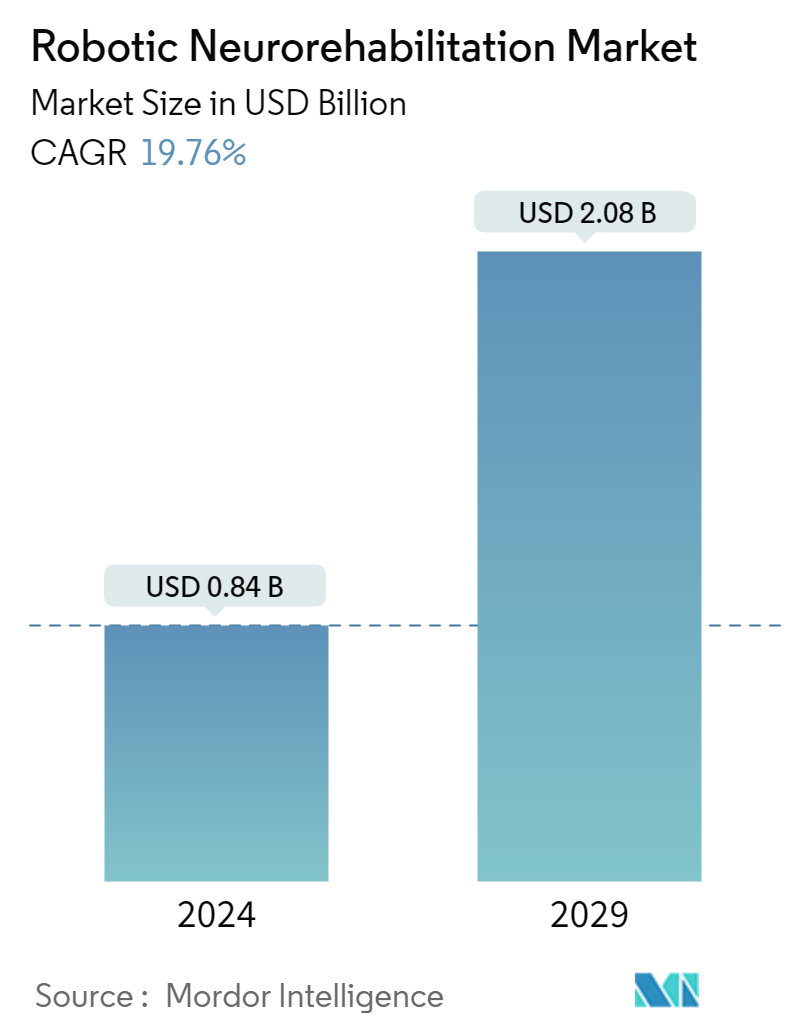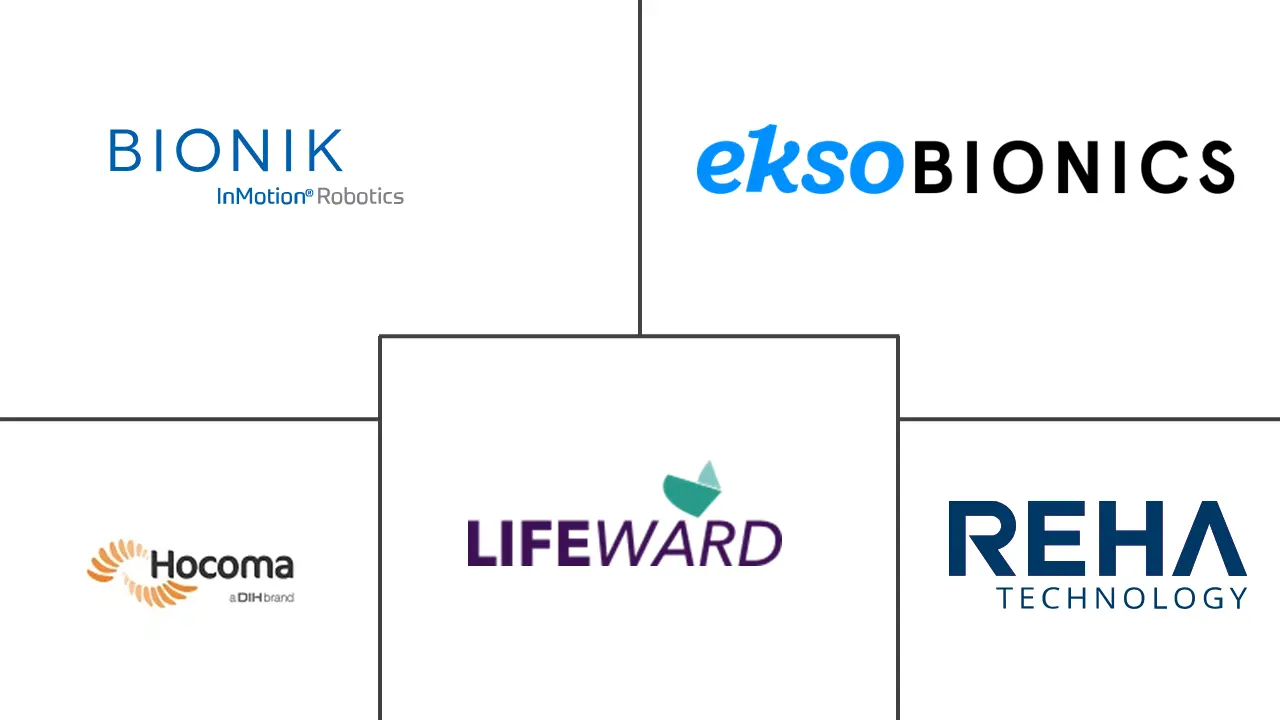Market Size of Robotic Neurorehabilitation Industry

| Study Period | 2019 - 2029 |
| Market Size (2024) | USD 0.84 Billion |
| Market Size (2029) | USD 2.08 Billion |
| CAGR (2024 - 2029) | 19.76 % |
| Fastest Growing Market | Asia Pacific |
| Largest Market | North America |
| Market Concentration | High |
Major Players
*Disclaimer: Major Players sorted in no particular order |
Robotic Neurorehabilitation Market Analysis
The Robotic Neurorehabilitation Market size is estimated at USD 0.84 billion in 2024, and is expected to reach USD 2.08 billion by 2029, growing at a CAGR of 19.76% during the forecast period (2024-2029).
Robot-mediated neurorehabilitation is an emerging field incorporating advances in robotic technology with neuroscience rehabilitation to define novel methods for treating neurological disorders. The demand for these products and services is attributed to the increasing prevalence of neurological disorders such as Parkinson's disease, cerebral palsy, and multiple sclerosis, coupled with increasing cases of stroke and brain and spinal cord injuries. For instance, according to a study published by the Lancet Neurology Journal in March 2024, over 3.4 billion people across the world are affected by a diverse group of neurological conditions, of which the highest contributors are stroke, neonatal encephalopathy or brain injury, migraine, Alzheimer's disease, and other dementias. The increasing patient population with neurological diseases causing motor or cognitive impairments, especially in the rapidly aging population, is expected to surge the demand for neurorehabilitation therapy over the forecast period.
Furthermore, several studies suggested that rehabilitation robots, which include therapeutic and assistive robots, support the neurorehabilitation of persons with neurological injuries and help bridge the care gap. These robotic neurorehabilitation devices are based on motor learning, resulting from intensive, repetitive, and task-oriented motor activities that require a patient's effort and attention. For instance, as per a study published by the Medical Review in February 2024, robot-assisted therapy combined with task-specific training has shown superior results in upper extremity motor function and improvements in quality of life among the Chinese population within post-stroke rehabilitation. Therefore, the frequent lack of complete recovery makes it desirable to develop novel neurorehabilitative treatments suited to the patients and better targeting the specific disability. Thus, robotic care in rehabilitation may play an essential role in the coming years.
Moreover, the increasing number of rehabilitation facilities and growing investment to accelerate research and development activities to incorporate robotic technology in rehabilitation therapy are surging the demand for these products and services across the globe. For instance, in September 2023, Trilife Hospital invested USD 180.4 million (INR 1,500 crore) to establish five new hospitals with the introduction of robotic services for advanced neuro-rehabilitation in India. Such initiatives are expected to increase accessibility and improve clinical outcomes in patients with neurologic disorders and are anticipated to surge the demand for robotic neurorehabilitation solutions, leading to market growth.
However, there are numerous barriers to the adoption of robot technology in rehabilitation. Such high levels of investments, its relatively costly maintenance and routine operation, and the lack of acceptance from healthcare professionals may restrain the market's growth.
Robotic Neurorehabilitation Industry Segmentation
Robot-assisted rehabilitation is a type of technology that helps the functional recovery of patients with stroke, traumatic brain injury, cerebral palsy, spinal cord injuries, Parkinson’s disease, and multiple sclerosis. Robotic neurorehabilitation devices are typically based on motor learning, which requires a patient’s effort and attention to perform intensive, repetitive, and task-oriented motor activities.
The robotic neurorehabilitation market is segmented into product type, end user, and geography. The market is segmented by product type into devices, consumables, accessories, and software and services. By devices, the market is segmented into upper extremity and lower extremity. By end user, the market is segmented into hospitals/clinics, cognitive care centers, and other end users. By geography, the market is segmented into North America, Europe, Asia-Pacific, and Rest of the World. The report also offers the market size and forecasts for 13 countries across the region. For each segment, the market sizing and forecasts have been done on the basis of value (USD)
| By Product Type | ||||
| ||||
| Consumable and Accessories | ||||
| Software and Services |
| By End User | |
| Hospitals/Clinics | |
| Cognitive Care Centers | |
| Other End Users |
| Geography | ||||||||
| ||||||||
| ||||||||
| ||||||||
| Rest of the World |
Robotic Neurorehabilitation Market Size Summary
The robotic neurorehabilitation market is poised for significant growth, driven by the integration of advanced robotic technologies with neuroscience to develop innovative treatments for neurological disorders. This emerging field addresses the increasing prevalence of conditions such as Parkinson's disease, cerebral palsy, and multiple sclerosis, alongside rising cases of stroke and brain injuries. The demand for robotic neurorehabilitation is further fueled by the aging population, which is more susceptible to motor and cognitive impairments. Rehabilitation robots, including therapeutic and assistive devices, play a crucial role in bridging care gaps by facilitating intensive, repetitive, and task-oriented motor activities. These devices are designed to enhance mobility and improve quality of life, particularly in stroke rehabilitation, where they have shown superior results in motor function recovery. Despite the promising benefits, the market faces challenges such as high investment costs, maintenance expenses, and varying acceptance among healthcare professionals.
The market is expected to expand significantly, with North America leading due to its established healthcare infrastructure, presence of key players, and increasing geriatric population with neurological disorders. The region's growth is supported by government funding and research grants aimed at advancing neurorehabilitation technologies. Strategic partnerships and collaborations among market players are anticipated to drive technological innovations, further enhancing the market's growth prospects. The competitive landscape is characterized by the dominance of established companies like Hocoma, BIONIK, Lifeward, Inc., and Ekso Bionics, which are actively involved in expanding their market presence and developing advanced rehabilitation solutions. As the demand for robotic neurorehabilitation solutions continues to rise, driven by technological advancements and increasing prevalence of neurological conditions, the market is set to experience substantial growth over the forecast period.
Robotic Neurorehabilitation Market Size - Table of Contents
-
1. MARKET DYNAMICS
-
1.1 Market Overview
-
1.2 Market Drivers
-
1.2.1 Increasing Prevalence of Neurological Disorders
-
1.2.2 Clinical Outcomes Offered Over Conventional Methods
-
1.2.3 Technological Advancements in Robotic Devices
-
-
1.3 Market Restraints
-
1.3.1 High Cost Associated with Robotic Neurorehabilitation Devices
-
-
1.4 Porter's Five Force Analysis
-
1.4.1 Threat of New Entrants
-
1.4.2 Bargaining Power of Buyers/Consumers
-
1.4.3 Bargaining Power of Suppliers
-
1.4.4 Threat of Substitute Products
-
1.4.5 Intensity of Competitive Rivalry
-
-
-
2. MARKET SEGMENTATION (Market Size by Value - USD)
-
2.1 By Product Type
-
2.1.1 Devices
-
2.1.1.1 Upper Extremity
-
2.1.1.2 Lower Extremity
-
-
2.1.2 Consumable and Accessories
-
2.1.3 Software and Services
-
-
2.2 By End User
-
2.2.1 Hospitals/Clinics
-
2.2.2 Cognitive Care Centers
-
2.2.3 Other End Users
-
-
2.3 Geography
-
2.3.1 North America
-
2.3.1.1 United States
-
2.3.1.2 Canada
-
2.3.1.3 Mexico
-
-
2.3.2 Europe
-
2.3.2.1 Germany
-
2.3.2.2 United Kingdom
-
2.3.2.3 France
-
2.3.2.4 Italy
-
2.3.2.5 Spain
-
2.3.2.6 Rest of Europe
-
-
2.3.3 Asia-Pacific
-
2.3.3.1 China
-
2.3.3.2 Japan
-
2.3.3.3 India
-
2.3.3.4 Australia
-
2.3.3.5 South Korea
-
2.3.3.6 Rest of Asia-Pacific
-
-
2.3.4 Rest of the World
-
-
Robotic Neurorehabilitation Market Size FAQs
How big is the Robotic Neurorehabilitation Market?
The Robotic Neurorehabilitation Market size is expected to reach USD 0.84 billion in 2024 and grow at a CAGR of 19.76% to reach USD 2.08 billion by 2029.
What is the current Robotic Neurorehabilitation Market size?
In 2024, the Robotic Neurorehabilitation Market size is expected to reach USD 0.84 billion.

